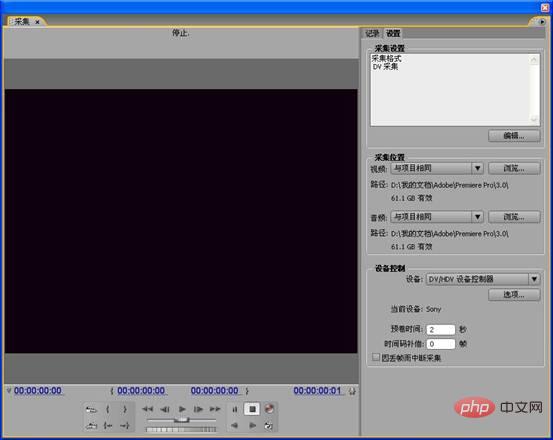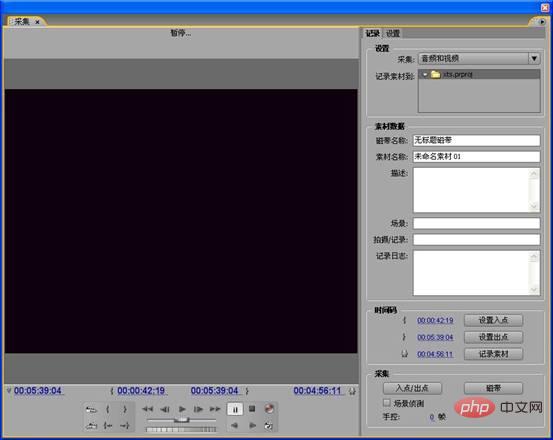Introduction to three methods of capturing DV videos in Premiere

For videos shot with tape DV, the video signals stored on the digital tape must be collected into the computer to form video files in avi format before they can be edited. Collection is very time-consuming. and energy things. The professional film and television editing software Adobe Premiere Pro has three different methods: tape capture, entry and exit capture, and batch capture.
1. Tape collection
The computer for collection needs to be installed with a 1394 card. It is available in the computer market for about 80 yuan. After buying it, insert it into the computer. It can work on the motherboard's expansion slot and does not require driver installation.
Plug one end of the 1394 special connecting cable into the 1394 port of the computer, and the other end into the digital camera. Load the recorded tape into the camera, set the camera switch to the VCR position, and turn on the power switch.
Open Adobe Premiere Pro, create a new project, operate the menu "File" - "Acquisition", or operate the menu "Window" - "Acquisition" to open the "Acquisition" window. Click the "Settings" tab of the acquisition window. As shown in the picture.

Click the "Edit" button, click "OK" in the pop-up "Project Settings" window, and return to the collection window.
Select "DV/HDV Controller" in the device list, click the "Options" button, and select "PAL" or "NTSC" for "Video System" in the "Device Control Settings" window depending on your camera system. , select "Universal" for "Device Brand" or your camera brand such as Sony, etc. After selecting, click "OK" to return to the collection window.
Click the "Record" tab in the collection window, as shown in the figure.

There are some controls at the bottom of the left side of the window. The upper middle row from left to right are fast rewind, frame by frame rewind, play, frame by frame forward, and fast forward buttons; The second row is the quick search button. According to the degree of toggle to the right, the tape can be controlled from slow forward to fast forward. According to the degree of toggle to the left, the tape can be controlled from slow rewind to fast rewind. This is the most commonly used control; The next row is a micro-adjustment dial. Use these controls to manipulate the movement of the camera tape to find the desired scene clip.
After finding the starting point of the required scene clip, click the "Tape" button at the bottom right side of the window, and the collection will start. To stop the collection, just press the ESC key on the keyboard. This is the first method. The collection method is suitable for the situation where the video signal on the entire tape is collected indiscriminately into the computer, and is relatively rarely used.
2. In-point and out-point collection
Usually when shooting, it is inevitable to capture many useless scenes. These useless scenes are discarded during collection and only the wonderful ones are captured. Just collect the scene clips into the computer. Use the controls to search for the beginning of the useful scene clip, click the "Set In Point" button on the right, and the computer will memorize the position of this point on the tape.
Use the control to search for the end of the clip, click the "Set Out Point" button on the right, and the computer will memorize the position of this point on the tape. Then click the "In Point/Out Point" button on the lower right side, and the tape will automatically return to the In Point position for collection. When the collection reaches the Out Point position, the collection will automatically stop.
Repeat this operation to collect all scene clips. This is the second collection method.
3. Batch collection
The difference from the second one is that when you find the in point and the out point and press "Set In Point" and "Set Out Point" After pressing the button to memorize, then click the "Record Material" button. The computer will not collect it for the time being. It will just add an offline empty material file entry to the project material list on the main interface of Adobe Premiere Pro.
You can follow this method to search and remember the entry and exit points of other clips one by one. After searching and memorizing all the clips on this tape, go to the project material list on the main interface of Adobe Premiere Pro and select all the offline material files, operate the menu "File" - "Batch Collection", and select "Batch Collection" in the pop-up "Check "Ignore material settings" in the window, click the "OK" button, and the computer will automatically control the camera tape to move to the entry point of each clip to start collecting.
You can go to sleep, a 60-minute digital tape, the collection time is not much shorter than 60 minutes.
The video file size collected from the computer is very large. If the screen size is 720×576, one minute of video is about 214MB. The file system of the hard disk that saves the video must be NTFS. If it is FAT32, the size of a file is not allowed to exceed 4GB. That is to say, if the length of a captured scene fragment exceeds 18 minutes, it will prompt that the hard disk space is insufficient.
Related recommendations: "premiere tutorial"
The above is the detailed content of Introduction to three methods of capturing DV videos in Premiere. For more information, please follow other related articles on the PHP Chinese website!

Hot AI Tools

Undresser.AI Undress
AI-powered app for creating realistic nude photos

AI Clothes Remover
Online AI tool for removing clothes from photos.

Undress AI Tool
Undress images for free

Clothoff.io
AI clothes remover

Video Face Swap
Swap faces in any video effortlessly with our completely free AI face swap tool!

Hot Article

Hot Tools

Notepad++7.3.1
Easy-to-use and free code editor

SublimeText3 Chinese version
Chinese version, very easy to use

Zend Studio 13.0.1
Powerful PHP integrated development environment

Dreamweaver CS6
Visual web development tools

SublimeText3 Mac version
God-level code editing software (SublimeText3)

Hot Topics
 1387
1387
 52
52
 Recommended desktop computer configuration for video editing
Apr 22, 2024 am 10:07 AM
Recommended desktop computer configuration for video editing
Apr 22, 2024 am 10:07 AM
Install a computer mainly used for video editing: Lenovo ThinkPad X1: X1 has a built-in active stylus, the keyboard automatically retracts in tablet mode, and supports fast charging. The X1 has a solid black appearance and a 4KHDR screen, making it easy to edit videos, program software, etc. The downside is that the Ethernet port requires a dedicated adapter. Regarding memory issues: It is recommended to use memory modules of 16G or above. Because in order for the computer to edit high-definition videos without lagging, large memory is a necessary configuration. On the hard drive issue: Two hard drives can be installed. Monitor: Choose a high-resolution monitor for clearer viewing and editing of video footage. A monitor with 4k resolution or above is recommended. Operating system: Common editing software such as Adobe Premiere
 What is the solution to jitter and shaking in video editing? Why is the screen shaking?
May 02, 2024 am 11:37 AM
What is the solution to jitter and shaking in video editing? Why is the screen shaking?
May 02, 2024 am 11:37 AM
Video editing has become a very important industry. During the video editing process, screen jitter and shaking are a common problem, which has a great impact on the quality of the video. So, what is the solution to screen jitter and shaking? 1. What is the solution to jitter and shaking in video editing? 1. Use a stabilizer. A stabilizer is an important piece of equipment during video shooting. It can effectively reduce the shake and shaking of the picture. During the video editing process, if the original video image is jittery and shaking, you can use a stabilizer to process the image to make it more stable. Use a stabilizer to make the picture more stable. 2. Stabilization function in video editing software Nowadays, most video editing software has the function of stabilizing the picture.
 Arc A770 surpasses RTX 4060 in Adobe Premiere Pro 2024 Beta, adding Intel independent graphics hardware codec support
Aug 18, 2023 pm 01:49 PM
Arc A770 surpasses RTX 4060 in Adobe Premiere Pro 2024 Beta, adding Intel independent graphics hardware codec support
Aug 18, 2023 pm 01:49 PM
Intel launched the first-generation Arc A770 and A750 discrete graphics cards in October 2022, but software support will take some time to catch up. According to Pugetsystems’ findings, the latest Adobe Premiere Pro 2024 Beta Build 22 beta version has officially supported Intel Arc GPU hardware encoding and decoding, including H.264 And full support for HEVC, although we don't recommend the beta version for daily use, for those who don't like NVIDIA and AMD graphics cards, especially the Intel Arc series graphics cards which have stronger codec support than NVIDIA and AMD. This is very important. Adobe has officially released this series of work
 How to make dynamic watermark in Premiere_How to make dynamic watermark in Premiere
Apr 29, 2024 pm 04:30 PM
How to make dynamic watermark in Premiere_How to make dynamic watermark in Premiere
Apr 29, 2024 pm 04:30 PM
1. Open the PR software, create a new project, import the video material and put it on the track. 2. Use the text tool to add watermark text. I used XXX instead. You can also put a pre-made watermark LOGO picture. 3. In the opacity, lower the parameters appropriately so that the watermark is not too eye-catching. 4. Add key frames to the position. From the beginning to the end, move the watermark position every once in a while. The parameters are arbitrary and key frames are created every time. 5. Click play and you can see the dynamic watermark moving around the screen.
 How to blur video edges in Premiere_How to set feathered video edges in Premiere
May 08, 2024 pm 02:16 PM
How to blur video edges in Premiere_How to set feathered video edges in Premiere
May 08, 2024 pm 02:16 PM
1. First, let’s import a piece of material for demonstration. 2. Drag the material into the timeline panel. 3. Let’s take a look at the material. We can find that the edges of the fallen leaves in the lower half are stiff, which is not ideal for blending into such a scene. So I'm going to blur the edges of it. 4. Find it in the effects panel and double-click the feather edge to add the effect. 5. Adjust the blur amount so that the edges can achieve a blurred effect. 6. Take a look at the effect after processing. You can find that the edges of the fallen leaves have been blurred. Similarly, this method can be used in different scenarios. Friends can use this example to draw inferences. 7. Finally, let’s take a look at the finished animation effect.
 How to mirror flip pr2020 video_How to mirror flip pr2020 video
Apr 29, 2024 pm 03:00 PM
How to mirror flip pr2020 video_How to mirror flip pr2020 video
Apr 29, 2024 pm 03:00 PM
Start by searching for the Flip effect in the Effects panel. You can see vertical flipping and horizontal flipping in the picture below. The horizontal flip can realize the left and right swap of the video. The character in the original video is on the right side of the video. Then hold down the left mouse button and drag to the video track for horizontal flip effect. At this point you can see that the video has been flipped left and right. The person in the video appears on the left. The flipped video can have objects within it masked.
 How to create star glow effect in Premiere_Steps to create star glow effect in Premiere
Apr 29, 2024 pm 01:46 PM
How to create star glow effect in Premiere_Steps to create star glow effect in Premiere
Apr 29, 2024 pm 01:46 PM
1. Open PR and select the material video that needs to be processed. 2. Find [starglow] in the effects. 3. Drag the effect directly to add it to the material. 4. In the preset, select a more suitable style. 5. Adjust the lighting parameters appropriately. That’s it
 Sora comes to Adobe video editing software! The new version of Premiere Pro opens the era of AI editing
Apr 16, 2024 pm 03:20 PM
Sora comes to Adobe video editing software! The new version of Premiere Pro opens the era of AI editing
Apr 16, 2024 pm 03:20 PM
Sora is going to be integrated into Adobe video editing software. In the newly released PremierPro concept demonstration, Adobe showed the results of its cooperation with OpenAI: in addition to the main lens, a B-roll auxiliary lens was completely generated by Sora. In addition to Sora, other popular AI video tools Runway and Pika will also be available as options. Runway is used similarly to Sora in the demonstration and can generate a new auxiliary shot. Pika can naturally extend existing lenses for several seconds. It should be emphasized that these features are still in the early preview and research stage, and it has not yet been revealed when they will be released. In comparison, Adobe’s own AI product Firefly




